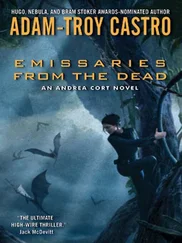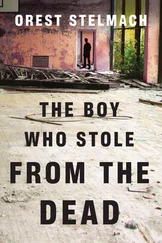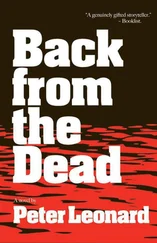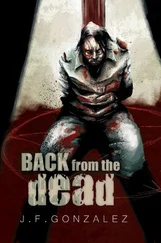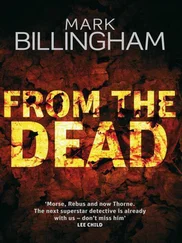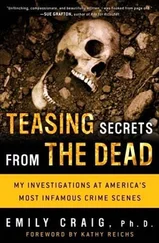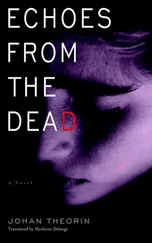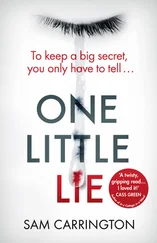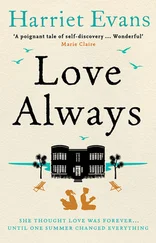I was eager to get on to the keys and the coin, but it would take hours to clean off the corrosion that had been building up over the years, and I was even more eager to look at the bones. By now, my examining room was crammed full of gurneys stacked with evidence, notepaper, and cameras, so I set to clearing some space while Lambers finished with his notes and pictures. Once again my hands went on autopilot while my mind roamed free. I could almost see our victim now: a wealthy man, well dressed in a business suit, leather gloves, and knee socks with garters. He had a faintly European air, and he carried himself like a man who was used to the best: a monogrammed money clip, a gold Cross pen and pencil set. For some reason, he'd gone or been taken down to an isolated spot on the banks of the Ohio. And there was something else: Someone had held a gun to his skull and pulled the trigger.
By now I'd moved all the other evidence onto the counters lining the periphery of the lab, and I was ready to start with the bones. As I took each one out of its evidence bag, I laid it out on the gurney, so that a disarticulated skeleton gradually emerged. I finally added the skull and mandible. Our guy's face and jaws were still covered in debris from the grave, but I knew from yesterday's quick field exam that he'd had several gold crowns and fillings in his mouth. The x-rays that Mark had taken yesterday had revealed more fillings, bright white spots on the film that were the same density as the bullet.
Now, as I carefully brushed away the sand, mud, and traces of lime, I was treated to another welcome surprise. These teeth had not only been crowned and filled with gold, they'd been extremely clean and well cared for, with no evidence of active decay at the time of death.
“This was no derelict,” I told Lambers. “He had money right up until he died.” So far, we might have been dealing with someone who'd once been wealthy but who had gone on to face hard times. I'd seen many such cases before: a man who becomes destitute after years of comfortable living; the daughter of wealthy parents who pay for her expensive composite fillings only while she lives at home. You see signs of expensive dental care, yes, but you can also read the hard times that came later: the cavities, the buildup of tartar and calculus, the gum disease. You might even notice a missing tooth or two.
Not with this guy. Although decades of chewing had ground down the surfaces of his teeth a little, he had maintained a nice smile until the day he died-a nice, expensive smile.
I looked more closely at the man's skull, trying to imagine his face. His head was large and well rounded, with a square jaw that fit well into the temporomandibular joint, the place where the mandible attaches to the skull. That joint showed no signs of arthritis, so he'd had no trouble chewing with those well-kept teeth. The bridge of his nose was formed by exceptionally large, prominent nasal bones. I pictured a big protruding nose, and then a huge forehead, the flesh jutting out to cover the heavy brow ridge. He'd have had a rugged, masculine face, with well-proportioned features and a sparkling smile. Judging by the clothes he'd worn, he'd had a significant amount of flesh covering these big bones. I noticed the well-defined muscle insertions, which usually indicate big, strong muscles. He was probably a hefty guy, but not fat. More meaty, like a wrestler. Or maybe a football player?
Lambers was getting restless. After all, we already knew that this man was a large White male. What else could the bones tell us? I decided to go back to my thinking-out-loud method, so Lambers could share in my search.
“So far, I haven't seen any old fractures, but the ends of the long bones and the lower spine had started to show some wear. Those teeth of his had worn down a little too, so I think we could bump his age up into the forty-to-fifty-five range.” I wanted to narrow that down, but it'd have to do for the moment. “Now, let's see how tall this guy was.” I opened a cabinet and pulled out a giant set of sliding calipers.
In spite of himself, Lambers was intrigued. “What are you going to do, Doc? Connect all these bones and measure from top to bottom?”
“Luckily, I don't have to. I'm just going to measure his thigh bone and then ask the computer here to figure out the rest.” Anthropologists before my time made great progress in estimating stature by using mathematical formulas and statistical analyses. These formulas have recently been computerized and bolstered by data from modern forensic cases, so now all I had to do was type in the femur measurement. A computer program called FORDISC 2.0 would do the rest.
I laid the man's femur flat on the counter, placing one straight flat needle of the caliper against the bottom side of the knee and the other against the rounded ball at the top. Most anthropologists use an osteometric board to take these measurements; it resembles a fish-measuring board, or one of those devices that measures your foot at the shoe store, but I find that a caliper is just as accurate and much more efficient, especially when the bones in question are still covered with flesh. The osteometric board only works on free-standing bones, but I can insert the needles of my calipers into the joints and ends of bones that are still attached to a body.
This femur was 536 millimeters long. When FORDISC 2.0 learned that these measurements had belonged to a White male, it obligingly reported a height of 6 feet, 4 inches, give or take a few inches.
“He was huge,” remarked Lambers, who looked about 5'10'' at most.
“I'm 5'8''.” I nodded in agreement at him before looking at my sketch of the suit. “Yeah, he was pretty bulky. But given how tall he was, I don't think he was roly-poly fat, just big all over. I'd say he weighed close to 250 pounds. So when we start going through missing persons files, we can knock out the short, skinny guys immediately.”
Identifying this man was everybody's top priority at the moment. News of our discovery had hit the airwaves all over northern Kentucky and southern Ohio, and my voice mail was already clogged with messages from reporters. Luckily, departmental protocol wouldn't let me talk to the press this early in the process; I could only discuss this case with the coroner and the detective in charge. So I called Mark and Detective Daly and told them what we'd learned. We all knew it was crucial to capitalize on this narrow window of opportunity while the press and the public were still interested.
Mark and Daly listened eagerly as I ran down our discoveries. Then Daly asked the one question I couldn't answer: “How long do you think he's been dead?”
As I'd done yesterday, I shook my head. “It's been a while, I'll say that much. Twenty years? Twenty-five? Let's keep it vague for now. Maybe tomorrow I'll find out more.”

The next morning there was an e-mail message waiting for me from Daphne Harris, proprietor of the Red Rose Vintage Clothing Company in Indianapolis. To my amazement, she had answered me right away, estimating that the suit I'd sketched had been made sometime between 1955 and 1963. I immediately sent her pictures of the eyeglasses and the monogrammed money clip, and her answers were similar: 1955 to 1965 for the glasses, and the 1940s or 1950s for the clip.
Well, that at least gave us a back date. But maybe this guy was just old-fashioned. Or maybe he was wearing someone else's stuff, though I couldn't think of a reason why he'd do that. I was longing for a more precise date of death, but I knew we'd been incredibly lucky to get as much as we had. If all we'd had was the bones, we'd have been stuck.
By this time, local and state police agencies had already searched their missing persons files, and they had no records matching my description. That wasn't surprising for a case that was at least two decades old. It was even less surprising for this particular corner of Kentucky, which had been a lawless center of illegal gambling and prostitution from the 1930s through the 1960s. The Cleveland Syndicate, a Mafia-related crime ring heavily into gambling, had moved in right after the end of World War II and had remained in control until the 1960s, when U.S. Attorney General Robert Kennedy and his colleagues began lengthy investigations into the problem and backed political reformers in the whole region, including Campbell County.
Читать дальше


